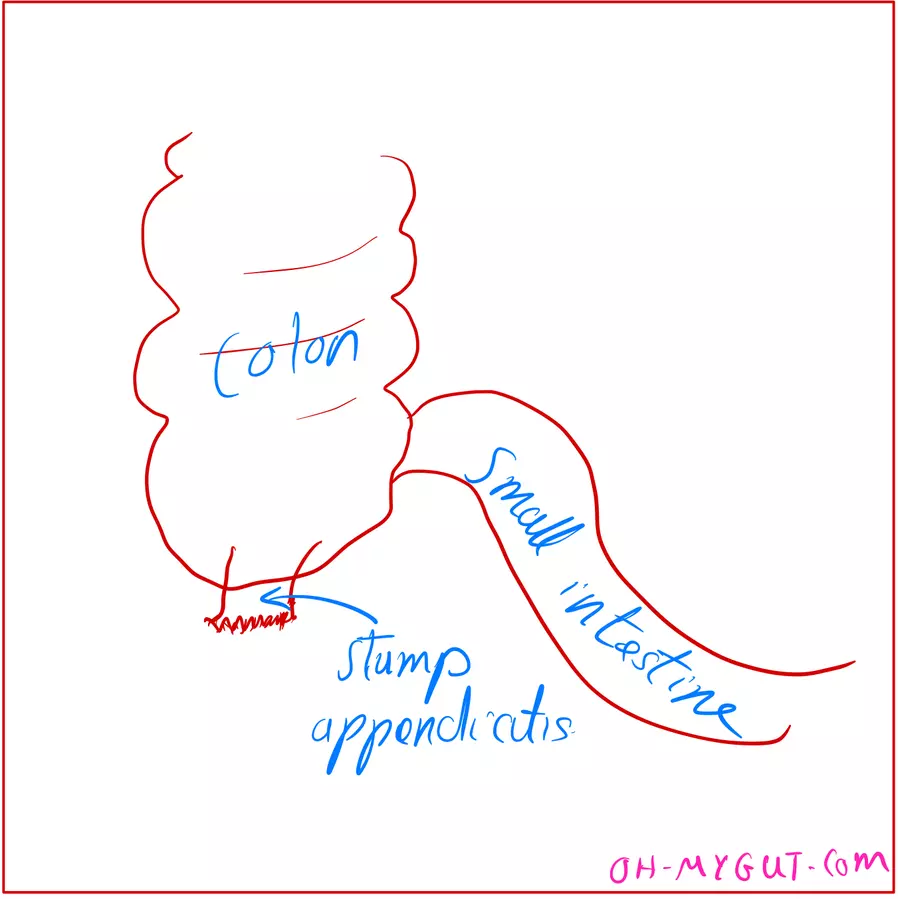Stump Appendicitis: Can the Appendix Grow Back? Gastroenterologist Explains.
Our content is not intended nor recommended as a substitute for medical advice by your doctor. Use for informational purposes only.
Can the appendix grow back again after being removed?
The appendix doesn’t grow back again after the appendectomy operation. However, Your surgeon may miss a part of the appendix during the operation (called the stump).
During appendectomy, your surgeon cuts the appendix and closes its root with sutures. Tissues only grow to a minimal extent to close the wound (wound healing). The appendix can’t grow back to a full appendix.
However, the operation can be complex, and your surgeon may not altogether remove the appendix (leaving a stump).
Leaving a stump can be due to many factors such as:
- The deep location of the appendix (retrocaecal appendix).
- Extensive inflammation at the site of the operation.
- Presence of appendicular abscess.
- Perforated appendix.
In such cases, the complete removal of the appendix is difficult. Instead, your surgeon leaves a part of the appendix attached to the colon.
Can appendicitis come back again after an appendectomy?
Appendicitis can recur again in rare cases. For example, when a significant portion of the appendix is left behind, it can get inflamed and cause appendicitis again. This condition is called (stump appendicitis).
Stump appendicitis is rare. The exact frequency of stump appendicitis is not known. Some studies estimate that stump appendicitis occurs one to 5 in every 50,000 appendectomies (reference).
Stump appendicitis is almost identical to appendicitis. The left stump can get inflamed by the exact mechanism of original appendicitis.
The stump often gets obstructed (by a stone or feces). Next, the obstruction leads to inflammation, mucus, and bacteria build-up.
Soon, The typical clinical picture of appendicitis develops. Unfortunately, the incidence of complication is higher with stump appendicitis because of late diagnosis.
Because of the previous appendectomy operation, you and your doctor will miss the diagnosis at first.
Diagnosis is often late, causing more incidence of complications. Common complications include abscess formation and rupture of the appendix.
According to one study, the incidence of complications with stump appendicitis is up to 70% (reference).
How long does it take for stump appendicitis to come back?
Stump appendicitis is similar to classical appendicitis in its development, clinical picture, pain location, and complications.
No definite time for the left stump to inflame. Appendicitis pain can come back anytime from few weeks to several decades. One study found that stump appendicitis can develop up to 50 years after the appendectomy operation (reference).
Stump appendicitis is unlikely to occur immediately after the operation. The strong antibiotics and analgesics in the few days after the appendectomy operation prevent its development.
The takeaway is not to ignore the typical pain at the site of an appendectomy operation. Not every pain is considered stump appendicitis. The pain has to be specific for appendicitis (see the next section).
Symptoms of stump appendicitis.
- The pain from stump appendicitis often starts around the umbilicus.
- Next, the pain shifts to the right lower abdomen (however, this is not typical for all cases).
- The pain from appendicitis markedly increased with movements, straining, coughing, or bending your thigh.
- The pain rises over time. It is not typical for appendicitis pain to remain mild or intermittent.
- The pain is sharp and constant, unlike gastroenteritis or IBS, which is in the form of colics that comes and goes.
Associated symptoms include (reference):
- Nausea and/or vomiting.
- Lost appetite (anorexia).
- Fever (in 40%).
- Diarrhea.
- Body aches and generalized fatigue.
- Sometimes, urgent desire to pass urine.
Complications:
- Abscess formation.
- Gangrene: Severe inflammation and edema prevent blood from reaching the appendix tissues. The cutting of blood supply leads to the death of the appendix tissues (gangrene). Gangrene often leads to a burst (rupture) in the appendix.
- Perforation (rupture of the appendix): the risk increases as time passes without diagnosis and treatment.
- Peritonitis: the peritoneum is a thin double-layered membrane that envelops most of your abdominal organs. Peritonitis results from a ruptured appendix or appendicular abscess. Peritonitis results in more extreme symptoms such as high-grade fever, intense abdominal pain, and tenderness.
How your doctor diagnoses stump appendicitis?
Stump appendicitis occurs in patients who underwent appendectomy before. However, if you and your doctor are unaware of such a condition, the diagnosis can be challenging.
Your doctor makes an initial diagnosis on a clinical basis. The distinctive character and site of pain is the first step in the diagnosis of stump appendicitis.
Next, your doctor will confirm the condition using laboratory and imaging investigations such as (reference):
- A complete blood count: the white blood cell count is often increased with evidence of Bacterial infection (toxic granulation inside the white blood cells and increased neutrophil (a white blood cell type that is responsible for fighting bacterial infection).
- Abdominal ultrasonography.
- Abdominal CT or MRI (often more accurate than the ultrasonography).
- The definitive diagnosis is made when your doctor sees the inflamed stump during the surgery.
How is stump appendicitis treated?
The most effective treatment of stump appendicitis is surgery. Your doctor will need to remove the inflamed stump via open surgery or a laparoscope. Other non-surgical treatments (as antibiotics) aren’t as effective as surgery. Moreover, the delay in surgery can be a risk for complications.
Call your doctor immediately or go to the ER if you have typical appendicitis pain. Every minute counts as the delay in the diagnosis is serious.
- Evidence-based
- Written by a doctor.

Related Posts:
- Can Stress Cause Appendicitis? Gastroenterologist Explains.
- Can Gallbladder Pain Affect your Back Only?…
- Mid Back Pain (Right Side): 6 Causes & How to Differentiate.
- Untreated Pancreatitis: 6 Possible Scenarios…
- When to worry about ALT levels? Gastroenterologist Explains.
- Stabbing Chest Pain When Swallowing: 5 Causes,…












